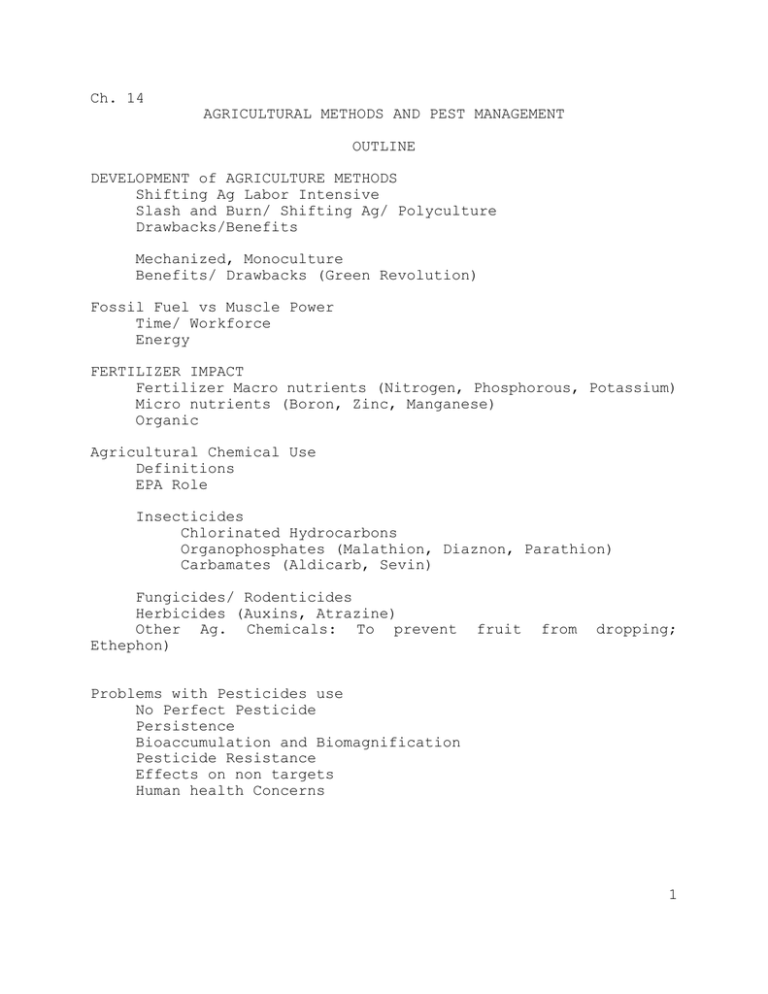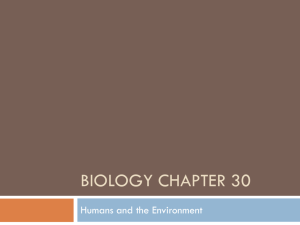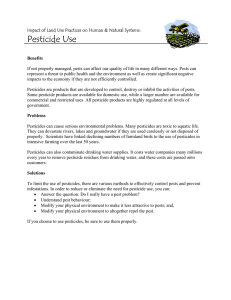ENV Ch 14 Ag methods.doc
advertisement

Ch. 14 AGRICULTURAL METHODS AND PEST MANAGEMENT OUTLINE DEVELOPMENT of AGRICULTURE METHODS Shifting Ag Labor Intensive Slash and Burn/ Shifting Ag/ Polyculture Drawbacks/Benefits Mechanized, Monoculture Benefits/ Drawbacks (Green Revolution) Fossil Fuel vs Muscle Power Time/ Workforce Energy FERTILIZER IMPACT Fertilizer Macro nutrients (Nitrogen, Phosphorous, Potassium) Micro nutrients (Boron, Zinc, Manganese) Organic Agricultural Chemical Use Definitions EPA Role Insecticides Chlorinated Hydrocarbons Organophosphates (Malathion, Diaznon, Parathion) Carbamates (Aldicarb, Sevin) Fungicides/ Rodenticides Herbicides (Auxins, Atrazine) Other Ag. Chemicals: To prevent Ethephon) fruit from dropping; Problems with Pesticides use No Perfect Pesticide Persistence Bioaccumulation and Biomagnification Pesticide Resistance Effects on non targets Human health Concerns 1 Why Use Pesticides So widely? ALTERNATIVE to CONVENTIONAL AGRICULTURE Sustainable Agriculture Organic Food Techniques for Protecting Soil and Water Resources Precision Agriculture Integrated Pest Management Disrupting Reproduction Using Beneficial Organisms to Control Pests Developing Resistant Crops. Modifying Farming Practices Selective Use of Pesticides Food Additives ORGANIC FARMING Conventional farming INTEGRATED PEST MANAGEMENT 2 Agricultural Methods and Pest Management Agricultural Methods : Shifting Ag Labor Intensive: common in many undeveloped countries. Causes - Economics Plot sizes and shapes Soil type and topography Crop type (handling need.) When growing site is not suitable for using machines. Slash and Burn: a variety of crops raised. Polyculture Benefits - Food production Insect problems reduced. Drawbacks - Soil erosion Nutrients released Forest re-growth is slow. Mechanized Agriculture (Monoculture): as in the US. All plants germinate at the same time, resist the same pests, ripen at the same time, grow to the same height. Hybrid and GE foods Results from - Plot sizes and Topography Fuel availability/Economics. Drawbacks - Soil erosion Organics removed from the soil Fertilizer and pesticide use necessary (high pest risk) No crop rotation Hybrid seeds are necessary to produce uniformly. Benefits - Production increase Improved crop variety Human and animal energy replaced by mechanism Machine and labor efficient. The Green Revolution. Energy vs Labor (muscle power) 1. It takes about 1/10 the time it took 100 years ago, to produce the same quantity of food. 2. Today, 3% of the US work force is involved with farming. Compare with India where 64% produces between 1/2 and 3/4 of the US yield. Reasons: 1. Fuel energy replaces labor (energy used to irrigate, till, plant and harvest). 2. Fertilizer energy is added to the soil. (It takes 5 met. tons of hydrocarbons to produce 1 met. ton of Fertilizer. 3 Fertilizer Impact a) 25% of the food produced worldwide, is directly attributable to fertilizer use. b) Fertilizer use is anticipated to increase by 30% every 10 years. c) Fertilizer cost is tied to oil prices (cost of living) d) Fertilizer replaces inorganic nutrients and labor. Chemical fertilizers provide the Primary Soil Nutrients, namely: Potassium, Phosphorous and Nitrogen compounds - MACRONUTRIENTS MICRONUTRIENTS in contrast are needed in very small quantities (gms) includes Zinc, Boron and Manganese. When micronutrients are not replaced in the soil, yields are much lower. Soils need ORGANIC MATTER, which is not replaced by chemicals. The organic matter 1. Maintains the soil structure 2. Affects the soil chemistry (lowers pH, releases nutrients) 3. Provides the energy for bacteria. In contrast, over abundance or poor timing in fertilizer spreading causes surface water pollution. Agricultural Chemical Use Pesticides Growth regulators Preservatives PESTICIDES (Insecticides) Pesticides are chemicals used to kill pests, ie. unwanted animals, bacteria or fungus. In Monoculture agriculture, large amounts are required. Pesticides are classified based on what organisms they kill. More appropriately should be called BIOCIDES and includes 1. Insecticides 2. Fungicides 3. Rodenticides 4. Herbicides 4 Pesticides are controlled by the EPA (charged by Congress to protect land, water and air systems). They are examined for: 1. Degradation - methods of decay & decay product. 2. Metabolism - Which organisms are acted on by the pesticide and the metabolic products released. 3. Mobility - pesticide movement thru the ecosystem. 4. Accumulation - dosage and probability of bioaccumulation. 5. Hazard potential - evaluation on target and non-target. Insecticides It costs between $10 to $50 M, to bring the product to market over an 8 to 12 year time period. Since 1867, > 60,000 compounds have been developed to kill insects. The 1st. inorganic was(Acetate + Arsenide of Cu ) Paris Green control the Colorado Potato beetle. The 1st. synthetic organic insecticide is DDT. 1942. The Greek poet (HOMER) discovered that some plants produce insect repellants, e.g. Tobacco, Marigolds, Chrysanthemums. However these are difficult to apply and show only a short term effect. Sulfur is also used to control insects. Types of Synthetic Insecticides (currently in use). Chlorinated Hydrocarbons, eg. DDT, Chlordane, Aldrin. They contain carbon, hydrogen and chlorine; are complex stable structures; persistent (hard pesticides), 10 to 15 years 1/2 life. Affect non-target organisms (their nervous systems). Tend to accumulate in soil and bodies of organisms. How compounds work is not fully understood. Banned in the US - NAFTA problem. Organophosphates, eg. Malathion , diazinon, Parathion.(very dangerous) These are soft pesticides, which decompose quickly- days. Frequent applications are required to be effective. The target is broad. Much more toxic to humans than DDT, as it interferes with the nervous system. It is very expensive, used for mosquito control. Carbamates, e.g. Sevin dust, Aldicarb. A soft pesticide, not as dangerous as organophosphates. 5 Fungicides Fungus may be a parasite or natural decomposer of organic matter. It can destroy a product or kill a plant. Therefore, fungicides are used to: 1. protect products from spoilage 2. prevent spread of disease 3. treat seed (Methylmercury- toxic to humans) Rodenticides are used to 1.Kill rodents responsible for consuming food supplies, carrying diseases and damaging crops while in the field. eg. Warfarin - causes internal bleeding. Use can be minimized by building rodent proof buildings. Herbicides Used to control unwanted growth in the wrong place (weeds) instead of labor (60% of pesticides). It is necessary to control weeds because they 1. remove nutrients and water from the soil 2. may shade crop 3. create problems in harvesting by reducing efficiency 4. must sort product before sale. Selective Herbicides, eg. machinery 2-4-5T (banned) and 2-4D. Auxins. These are synthetic Plant Growth Regulators which mimic natural growth regulators. They disrupt photosynthesis or inhibit enzymes, or destroy cells or precipitate proteins. e.g. Fenuron kills woody plants (commonly used on roadways.) Agricultural Chemicals (now available). Synthetic Auxins cause leaves to fall off before harvesting cotton. NAA prevents fruits from falling (apples) Ethephon causes fruit to fall easily (cherries). 6 Problems with Pesticides There are no perfect pesticides, namely: one which is 1. 2. 3. 4. inexpensive affect only the target has a short 1/2 life breaks down into harmless products. The primary problems are: 1. Persistence - still commonly used in undeveloped nations, because of stability. 2. Easily transported, eg. DDT 3.Bioaccumulate, concentrate in the fatty tissue. Biomagnification occurs at higher trophic levels. 4. Insects build up resistance. 99% are able to tolerate within 5 years. 5. Effect on non-target organisms. Kill both pest and useful insects. Targets are too general. 6. Usage is normally irreversible. 7. Users health is often affected. Effects on humans are not totally evaluated. Mutations, cancer and abnormal births. 9. Use can cause different pest problems to develop. *Cotton growers and Tobacco farmers use the most insecticides. Why use so much Pesticide? Food production up Pests consume 35% of grain produced worldwide. Economics (18.2 B$ in the US) Health problems impossible to control without pesticides. Effects on non-target organisms (of most pesticides) 1. Can harm birds, mammals and harmless insects. Kills both predator and prey and allows rapid increase of pests – irreversible. 2. Change population structure. Can cause a species that was not a pest previously to become one. Hence a different pest problem develops. Human health concerns Effects short and long term users and consumers. Users suffer a acute poisoning every year. Some deaths are due to misuse. It is proven to cause birth defects, mutations, and cancer in experimental animals. Last estimates, world wide: 1 – 5 M pesticide 7 poisoning/year and 20,000 deaths Food Additives 1. 2. 3. 4. 5. To prolong storage life - calcium propionate in bread. Improve color and flavor -monosodium glutinate, red dye. Modify nutritive value - iodine in salt. Reduce calories in food -nutrasweet Contaminants -DES in chicken. Alternative to Conventional Agriculture Before Synthetics/herbicides/agrochemicals Animal manure and crop rotation provided soil nutrients. Development of machinery No longer grow mixed crops or use of manual labor or use of draft animals. Today, as a consequence of chemical fertilizer development, larger fields are cultivated; there is no crop rotation and the opportunities for pest problems are enhanced. The alternatives are Alternative agriculture: includes all non-traditional methods, sustainable and organic agriculture, alternative methods for raising crops and producing crops for industrial use. Sustainable agriculture, which seeks methods to produce adequate, safe foods in an economic viable manner, and at the same time enhancing the health of the ecosystem. Organic agriculture advocates avoiding the use of chemicals and pesticides in food production. It is an ecological production management system that promotes biodiversity. Techniques for Protecting soil and water resources. Before insecticides, animal manure, Crop rotation and manual labor used to fertilize and provide nutrients and to kill weeds. Conventional farming causes the following problems Soil erosion Soil compaction. Organic matter reduction in the soil. Fertilizer runoff/ water pollution. To avoid these problems: 8 Reduce the quantity of fertilizer applied Increase the organic matter in the soil Careful selection and timing in the use of pesticides. Precision Agriculture – Use of computers Organic agriculture implies crop rotation, which (1) prevents pests and (2) is a method to enhance fertility. (3) slows soil erosion (4) produces food (5) lessens pollution (6) prohibits synthetic pesticides and fertilizers Possible Drawbacks to Organic farming Manual labor required for destroying weeds and insects, and yields are lower It requires a cattle operation to provide manure Lesser amounts of space available for cash crop Economics - profit of $50./hectare < conventional farming. Critics say: It cannot produce sufficient food to meet the needs of the world. That it is also uneconomic, except is special cases. Proponents note that: If soil erosion and pollution are considered, it is viable. Integrated Pest Management. To reduce the dependence on pesticides and to control pests, there are a variety of methods, namely: Based on understanding the ecological aspects of the crop Which crops are susceptible to what pests. The crop metabolism. Biological interaction between pests and predators Climatic conditions that favor pests Techniques which encourage beneficial insects Selective use of pesticides Genetic engineering. The methods used are: *Disrupting Reproduction: Spray sex attractants (pheromone Med fruit fly), Male sterilization *Release of natural predators or parasites *Modifying farm practices: Plowing under in the fall, reduce over wintering 9 *Selective use of pesticides *Development of crops with shorter maturity life span *Development of resistant crops/ crop rotation. *Gene engineering *Use naturally occurring pesticides in plants (marigold). Case Study Pelicans LA. Pelicans produced no young, egg shells thinned due to DDT. Investigation revealed source to be a DDT plant 1970. Court order to stop dumping waste offshore Population increased almost immediately. Waste is now trucked to a land-fill. Has the problem been solved? Herring Gulls: Indicators of contamination in the Great Lakes. They feed on fish, tend to accumulate toxic materials, such as: PCBs, organic compounds, used in fire retardants, lubricants, insulation fluids (in Transformers). Usage has stopped. Find less PCBs in gulls. Should the health of birds be considered when developing policy ? Contaminated Soils in the USSR: New lands being converted to agriculture. Fertilizers and pesticides used in abundance to increase production. Contamination results from excessive use; Contamination to GW and food products up 30%. Nitrates and pesticides contaminate 42% of baby foods. 14,000 deaths /year from contaminated foods. Now using DDT under law or new name. Agent Orange - 2,4D and 2,4,5 T + Dioxin. The name is derived from the drum color. > 100 M metric tons of herbicides were used in Viet Nam, starting 1965 Case Study Politics and the control of EDB (ethylene Di-Bromide) EDB causes cancer in rats. Dosage? 1970 data. EDB used to fumigate grain, fruit and soil. In 1984 the courts banned its use. EPA had to buy up all supplies and dispose of properly at a cost of $2.5 M + disposal. to 1970. Approx. 50 to 60,000 US troops exposed. On Lab animals, dioxin contamination proven dangerous. Italy suffered one disaster. 10 1984, Fed Court directed liability to soldiers. $180 M to be paid without admittance of New generation of Insecticides: most are highly toxic to many kinds of organisms. Starts with insect biology, develops a compound that interferes with the life cycle. Attacks specific chemical processes in cells, causing death Turn of the energy producing processes in cells, dangerous to birds and fishes. 11







